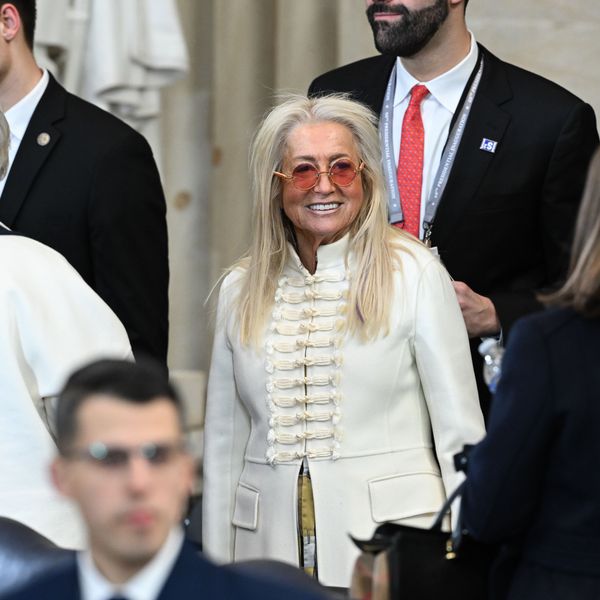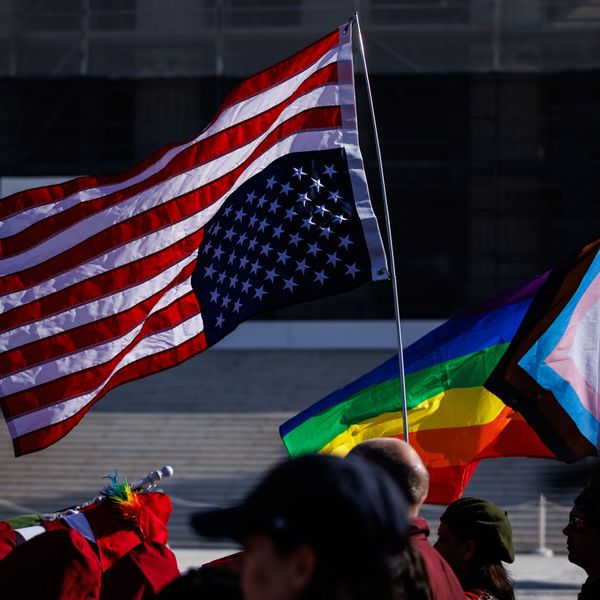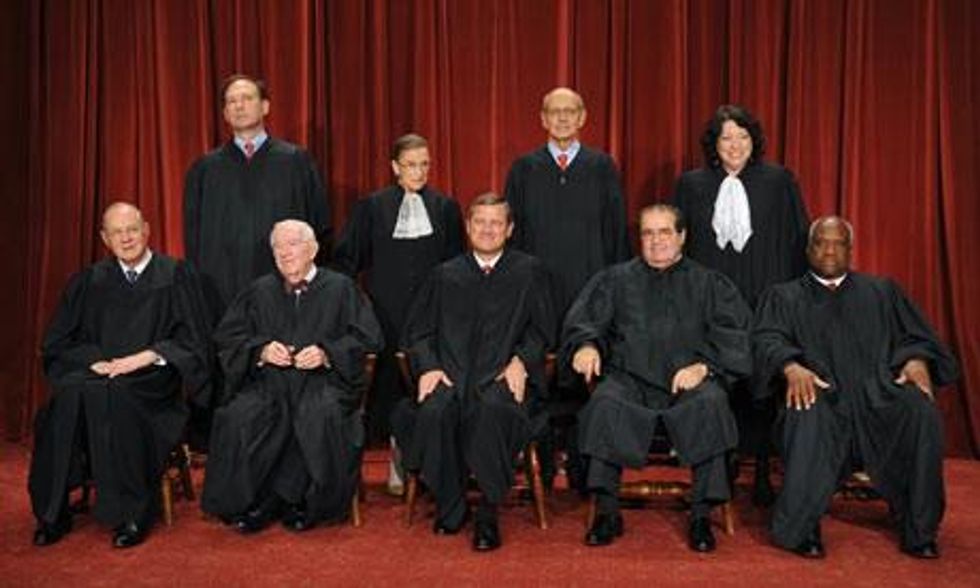This week, the country awaits the blockbuster ruling of the supreme court on the future of national healthcare in the United States. Citizens have waited anxiously every Monday morning for weeks for the next pronouncement - whether on immigration, free speech or, now, healthcare - to be handed down from the highest court. It has left many uneasy about the hold that such a small number of unelected jurists have on the nation.
Once again, many important decisions were the result of a court of one - 5-4 decisions, with "swing Justice" Anthony Kennedy deciding the issue for the nation. Healthcare is just one of a litany of cases that are reshaping the country in an image dictated often by just five members of the court. This has included sweeping changes in the political process from the Bush v Gore decision in 2000 (where the supreme court effectively chose the next president), to the Citizen's United case (where the court struck down campaign finance limits for corporations).
Also expected on Thursday is the decision in a free speech case, which many civil libertarians fear could deliver a huge blow to free speech in the United States. It is also expected to be a close vote.
While I support national healthcare, I have long opposed Obamacare on federalism grounds - denying states their constitutionally protected authority over such matters. Most experts are now predicting that the conservatives will likely carry the day in striking down critical parts of the law, or the law in its entirety. Despite being on the expected winning side of that particular case, I still believe that it is wrong for such a small group of jurists to make the decision for the country as a whole. In my view, the supreme court is demonstrably and dangerously too small.
Over ten years ago, I proposed a reform of the supreme court that would expand it to 19 members. A review of high courts around the world shows that most large nations have larger courts that avoid the concentration of power in the hands of so few jurists: Germany has 16, Japan 15, the United Kingdom 12, India 31, and Israel 15. Some use far greater numbers of justices who are divided among different divisions, like the 74 jurists in the Spanish high court or the 124 judges and deputy judges in France.
Again, while these systems have important structural differences, they do not have the concentration of power that characterizes the US supreme court. Canada does have a court that is the same size as the US supreme court, but the court has a mandatory retirement age of 75 that guarantees a higher turn over rate.
In drafting the US Constitution, the framers relied heavily on historical and contemporary models in other countries. So, today, a review of the function of larger courts around the world offers a better model for the modern court. The larger size of these courts does not produce administrative problems, while they allow greater diversity in experience and viewpoints.
The constitution itself does not specify the number of justices, and that number has actually fluctuated through the years. The nine-member court is a product not of some profound debate or study, but of pure happenstance. In fact, when the court first convened in 1790 in New York, at the Royal Exchange Building, it had six members. After that time, the size of the court expanded and shrank - largely with the number of federal circuits. Since justices once "rode circuit" and actually sat as judges in lower courts, Congress would add a justice when it added a circuit - or reduce the court with the elimination of a circuit. Thus, when a 10th circuit was added in 1863, a 10th justice was added at the same time. In 1869, the court happened to have nine members for the nine circuits. That is how we ended up with this size of a court.
Ever since the supreme court rested at nine members, we have repeatedly had problems of 5-4 splits, with one or two swing justices dictating the outcome of cases. With the increasing longevity of justices, such divisions have become stagnant and bitter. We often find ourselves captive to the idiosyncratic views of a couple of justices' views on privacy, or federalism, or free speech.
A national poll this month showed the public overwhelmingly opposed to how the court functions. Only 44% of citizens approved of how the court operates and 60% believe that "appointing supreme court justices for life is a bad thing because it gives them too much power."
The current controversy could not come at a more symbolic moment. This year is the 75th anniversary of the famous "court packing" effort of Franklin Delano Roosevelt. As today, the country in 1937 was in the midst of a profound economic crisis, and Roosevelt was saddled with four conservative justices - known as "the Four Horsemen" - who opposed his New Deal legislation. Roosevelt decided to introduce a bill to allow him to appoint up to six additional justices on the court. The crisis was averted when Roberts voted to support a critical New Deal case and "Horseman" Justice Willis Van Devanter retired - the famous "switch in time that saved nine" moment for the court. Roosevelt, though, may have had the right idea, for the wrong reason.
We can certainly debate the optimal number for the court, but we should finally have that debate after over 200 years. I believe a 19-member court would be ideal - roughly the average size of a circuit court. Appellate circuits are often divided between liberal and conservative judges. Yet, it is rare that one or two of those judges are consistently the swing votes on all issues when they sit "en banc" (or as a whole).
While appellate courts generally sit in three-judge panels, they sit as an en banc court in cases of great significance - the highest level of appeal short of the supreme court itself. In such cases, they function well as a whole and show greater diversity of opinion and experience. More importantly, the power of the judges themselves is diluted by the number. Experience has shown that a 19-member court is small enough to be manageable and would not present a significant burden in terms of confirmations.
Just because we settled on nine arbitrarily does not mean that any number is as good as any other. It is not enough to simply retort "why not 29 or 99?" One could just as easily ask "why not three or six?" The point is that we trying to decide on the best size for the court and should be able to look at other models objectively.
Both the recent polls and proposed reforms reflect a common concern that nine people should not wield such concentrated and sclerotic power. Even if we were to accept an elite court of just nine, these would not be the nine justices that most legal experts would choose. While clearly intelligent people, most justices are selected for their confirmability - a process that tends to favor formula nominees with a narrow range of experience and a short paper trail. The irony is that, because there are so few positions, confirmation fights have become increasingly bitter, so presidents have become increasingly risk-adverse. The result is that nominees are selected because they have never said or written anything remotely provocative - or even interesting. The chances that we could have again a Louis Brandeis or Joseph Story on the supreme court in the current system would be, at best, accidental.
If Congress ordered the proposed expansion, we'd get to a bench of 19 gradually, with no president allowed to appoint more than two new justices in a term. Once fully staffed, the court would have a more regular turnover. This would allow a broader range of diversity and more consistent opportunity for each president to add members to the court.
The expansion of the court might also allow Congress to force justices to return to the worthwhile practice of sitting on lower courts for periods of time. One of the greatest complaints heard from lawyers and judges alike is that justices are out-of-touch with the reality of legal practice and judging. A 19-member court would allow two members to sit on an appellate court each year by designation - and so actually be forced to apply the rulings that the court sends down to lower courts. Every five years, justices would be expected to sit as trial or appellate judges. The remaining 17 justices would sit each year to rule on cases.
Our experience with larger courts, both domestically and internationally, suggests that there is a better model for our highest court. Our respect for the court as an institution should not blind us to its flaws. It is time to reform - and expand - the US supreme court.


